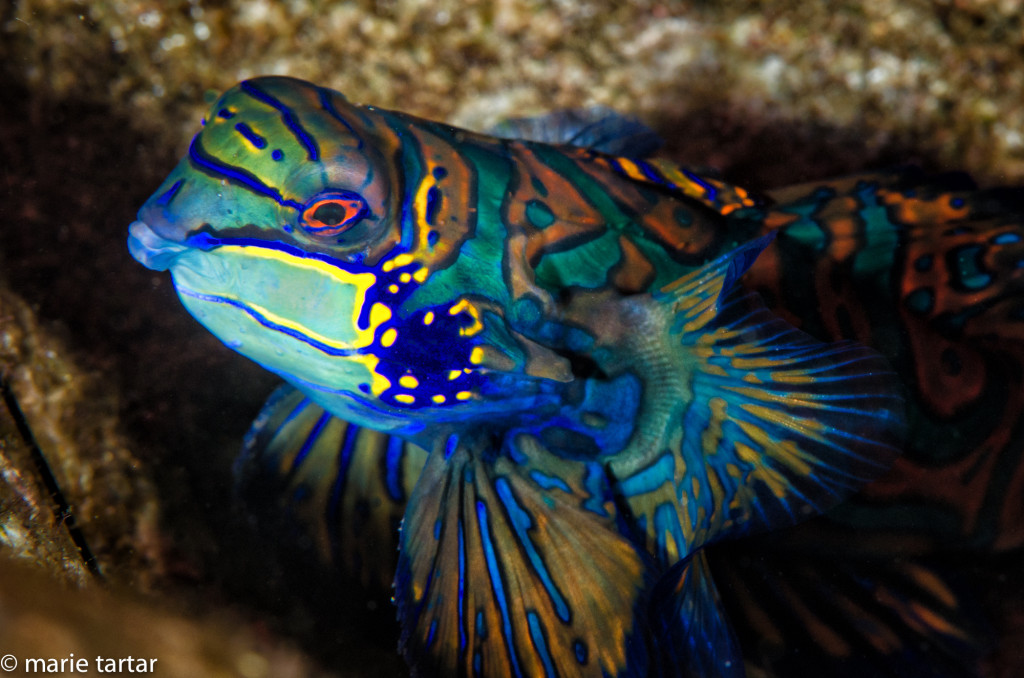
Our planned trip over was a leisurely one; our actual trip was both prolonged and compressed. We planned to overnight in Tokyo, a good night’s sleep on a fully horizontal bed hopefully offsetting 11 hours of discomfort in coach. I just couldn’t resist a bargain fare on All Nippon Airways, $1300 roundtrip LAX-Jakarta, via Tokyo, without the usual penalty for a stopover on the way back. Only 2 flights to Jakarta, arriving in time to overnight there near the airport, before an early departure for 3 short haul flights, hopscotching our way across Indonesia, to Sorong in West Papua to board the boat. On the way back, we’d stop off for 6 whole days in Tokyo without the usual penalty of a doubled fare or the equivalent in miles.
All the options for getting ourselves to and from LAX have different degrees of pain-in-the-rear factor for underwater photographers with a lot of gear. We settled on a new option which seemed alluringly pain-free: being driven in our own car by Howard, our occasional driver ($125 each way). He would collect us at 7 am, hopefully enough time before our noon departure, given the unpredictable variable of LA traffic.
Our start was auspicious. We sailed up to LAX in record time, with the least traffic I’ve ever seen on a weekday. We were done with checking in by 9 am, and headed to the Alaska Boardroom, where the Priority Pass allowed us a couple of quiet hours before heading to the gate.
We boarded on time and were underway right on schedule. The microphone soon broadcast the pilot’s reassuring voice, but not with the usual pleasantries, but the unwelcome news that our landing gear had not fully retracted. We circled around and around Catalina Island while checklists were checked, inspections and assessments made, and ultimately, dumped fuel into the ocean until the plane was unloaded enough to land again at LAX, 3 hours after we left. Not again! Two trips in a row, both international, with mechanical issues forcing a planeful of people to disembark and scramble. Hours after our take-off, the word came: we were being rebooked for the following morning. Another unexpected overnight stay in an airport hotel, this time at United’s expense. To their credit, while we were in line to rebook, we received an apology email, offering 10,000 miles or coupons for $250 credit as consolation for our inconvenience. While in the line, I managed to get ANA on the phone and rebooked our second leg to Jakarta. Instead of arriving in the afternoon, we’d get in around midnight, so our stay in the airport hotel would be much less restful.
Once we were settled at the Sheraton and able again to access the Internet, a bombshell email was waiting from Steve’s sister Susan, alerting us to terms of Steve’s fathers will. Frustrated to find ourselves 12 hours into our journey and only as far as LA, and determined to make something out of the day, we decided to head out for dinner at nearby Ayara Thai. We couldn’t seem to find an Uber X driver from the hotel, apparently due to proximity to the airport, so we headed off with an elderly Asian cabbie, a terrible driver, but not for the usual reasons. Usually cabbies are scary because they drive fast and skirt corners. This was the opposite, with the 5 minute drive doubled by his lurching, fits and starts style of “driving.” We later learned there was a “roller” earthquake while we were in the car, maybe contributing to his erratic driving.
We loved the restaurant, friendly and welcoming, attractive in a low-key way, sharing spicy shredded papaya pok-pok salad, Chu-Chee salmon with red coconut nut curry sauce and pork belly with Chinese broccoli. Our quick trip back to the hotel with an Uber X driver was a slick contrast to the halting procession that brought us to the restaurant.
The ground hog day sensation was acute on arriving at LAX the next morning for attempted departure number 2. The same faces in line at the same gate, the passengers only slightly rearranged in relative location. I passed the 11 hours in transit training for the Sedona film festival, watching movie after movie. The selection was enticing, many favorites I wanted to see again and many interesting titles I hadn’t managed to see. I loved “In A World,” directed by and starring Lake Bell as a daughter of a famous voice-over artist trying to break into the male-dominated business. We had actually gone with Greg to see this film at the Hillcrest cinema when he was visiting, arriving into the already darkened theatre a few minutes late, only to realize we were in the wrong hall. Rather than climb over a bunch of people trying to make it to our intended destination, we stayed, seeing the terrific coming of age film, “The Way Way Back” . To test my Spanish comprehension, I watched it dubbed into Spanish, with the English subtitles on.
I had wanted to see “Mandela: Long Road to Freedom” when it came out, but hadn’t made it, so was glad to have a chance to watch it. The lead actor, Idris Elba was terrific as this larger than life figure whose compelling and inspiring life story was well told and beautifully filmed.
My final pick was a Spanish language film from Spain, “Family United,” a comedic family drama. The youngest of 5 sons is to be married at his father’s ranch on the day Spain is in the final of the World Cup in South Africa.
We found refuge during our 4 hour layover in Narita at Korean Airlines Lounge, thankfully accepted by Priority Pass. This mellow lounge even offered a favorite Japanese snack: salmon onigiri!
Our 7 hour flight to Jakarta was marked by something I haven’t seen in years-a near empty plane! So empty, we opted to leave our bulkhead seats (good for reading but not for sleeping), in favor of each taking 3 seats across in coach. Still not very comfortable, but fully reclined, albeit with some indentations. It was midnight when we landed and later still on arriving to a hotel near the airport, less than 4 hours ahead of needing to head back to the airport for the final push.
More wrinkles awaited us on the final leg. Fred and the group were mobilizing in the lobby next morning in the dark. There was a last minute scramble on the hotel’s part to find a large enough bus and van to accommodate all 14 of us and our mounds of bags. We were in line at 5 am at the airport; in retrospect, cutting it too close for such a sizable group. Internal dive travel in Indonesia always means exceeding the allowed weight limits. On a typical trip, requiring at minimum 4 internal flights to and from, we usually are charged overweight bag fees on 1 leg. Which leg seems entirely arbitrary; in theory, we could be assessed these fees throughout, but depending on who is at the desk, their mood, alignment of the stars, or other nebulous factors, are usually not. Unfortunately for us, the group desk was manned by a smiling young woman who was clearly a stickler. Each checked bag was weighed; ours came in at 18-19 kg, more than the 15 kg limit. Not only that, we could only carry on one piece of hand luggage, not the two we had planned for. We fastened the Portercase’s locks and hoped for the best. Photo backpacks hoisted onto our backs, it was now only a few minutes before the scheduled 6 am departure. They were waving us onto the plane as we scurried to the gate area, a sure sign we were cutting it close. In fact, Fred and Jake were still at the desk trying to actually pay our collective overweight bag fees, and they did not hold the flight for them, despite lobbying from members of the group seated up front.
The Pindito isn’t one of the new super-luxury class of boutique live-aboards, but was one of the first boats to explore Raja Ampat. The wooden boat, built of Indonesian ironwood (ulin), is very solid feeling, over-engineered by its Swiss boat owner. It clearly is well cared for, shipshape, with every need anticipated. Sadly, one element I’ve always enjoyed on Indonesian dive trips was temporarily missing. The on board masseuse apparently broke his leg the weekend before we boarded.
Our first evening and full day was devoted to assembling cameras and dive gear, and to gathering up passengers waylaid along the way, including Michelle and Dan from Oregon who were caught up in a traffic jam and political demonstration en route to the airport, arriving too late to board. They were to have joined us in Manado, but instead had to fly all the way back to Jakarta in order to board a 1 am flight for Sorong, arriving in the morning in time to make the day’s dive. The dive site, 5 miles from Sorong, is named Bagasi Tidak Ada, Indonesia (per cruise director Johannes from Germany) for “luggage didn’t come.”
Our dive briefing by Johannes was amusing, describing an option for reboarding the speedboats as hoisting oneself up with fin kicks and over the side like a “stranded whale.” Since all the bathrooms are below decks, he said it was ok to make a beeline downstairs, even wet, if one returned from a dive with the “yellow eye” effect.
The dive itself served its purpose, basically for checking weight, equipment and camera function. The other Steve, from Orange County, had a disastrous start with a catastrophic flood, taking out his primary camera and macro lens, finding out the hard way he had swapped O-rings between 2 different camera systems, another cautionary tale of the hazards of building an underwater camera system while under the influence of jetlag and travel fatigue.
Fred and Jake, held up so long in Jakarta paying our overweight baggage fees that the plane left without them, joined us after lunch of beef curry, white rice and the local spinach.
After collecting the last of our stragglers, we set course south for Misool. Along the way, spinner dolphins accompanied us as the sunset heated up. Distant rain showers on the horizon lit up pink. After dinner, Johannes showed us video of spinner dolphins riding the bow wake, from the point of view of a Go Pro mounted underwater on the bow. Wow!
Although our first morning in Misool was planned for 2 dives, alternating with a continental “first breakfast” and a hot “second breakfast,” we were still underway on awaking the next morning and hadn’t yet reached our destination. It was overcast and rainy. The two planned breakfasts merged into one prolonged meal and eventually, we were divided into 3 groups, left, center, and right, and mobilized into the zodiacs to dive Ikan Mudah, near the island of Wagmab. The last group (right) entered into a strong current and had to abort after descending. They repositioned and I ran into them at the end of my dive. I saw a turtle head into the blue and practiced my wide angle lighting.
There always is an adjustment period getting used to life on the boat: how it rocks, what to step over. Usually one learns the safety hazards on each particular vessel by banging into things and stubbing toes the first few days. Our first full day one would have thought I was practicing to be a stunt person, falling 3 times. The first time was after breakfast. Like many boats, the Pindito’s dining room is lined with banquets. Usually, there are continuous benches encircling the room, fronted by tables, requiring those seated against the wall to slide across to openings between tables to exit. Which I did, flinging myself sideways, not realizing this bench was not continuous. I essentially flung myself onto the floor, straining my right rhomboid muscle, which I felt every time I had to reach out and lift something on that side. The other 2 occasions were slips on the deck near my gearbox, on a little patch of deck not covered by no-slip decking material. After that, I made a point to wear my grippy flipflops on deck. These misadventures left only a bruised dignity, but no real physical impairment. Steve did not fare as well, stubbing a toe in the shower, leaving it bruised, swollen and probably fractured. He didn’t miss a dive for it, buddy-taping it to its neighbor, but did skip a volcano climb later in the voyage.
Wed, April 2 (Misool)
Great night dive. No epaulet shark for us, although we did get to experience it later vicariously, via Tim’s nice video. There was plenty else to occupy us. While shooting a scorpionfish, a banded sea snake wove its way between me and the coral bommie, heading deeper than our planned max of 30 feet, on the hunt. I was surprised by a monster “parrot”fish under a ledge, covered with soft coral, behind which we sheltered from being blown away by the currant.
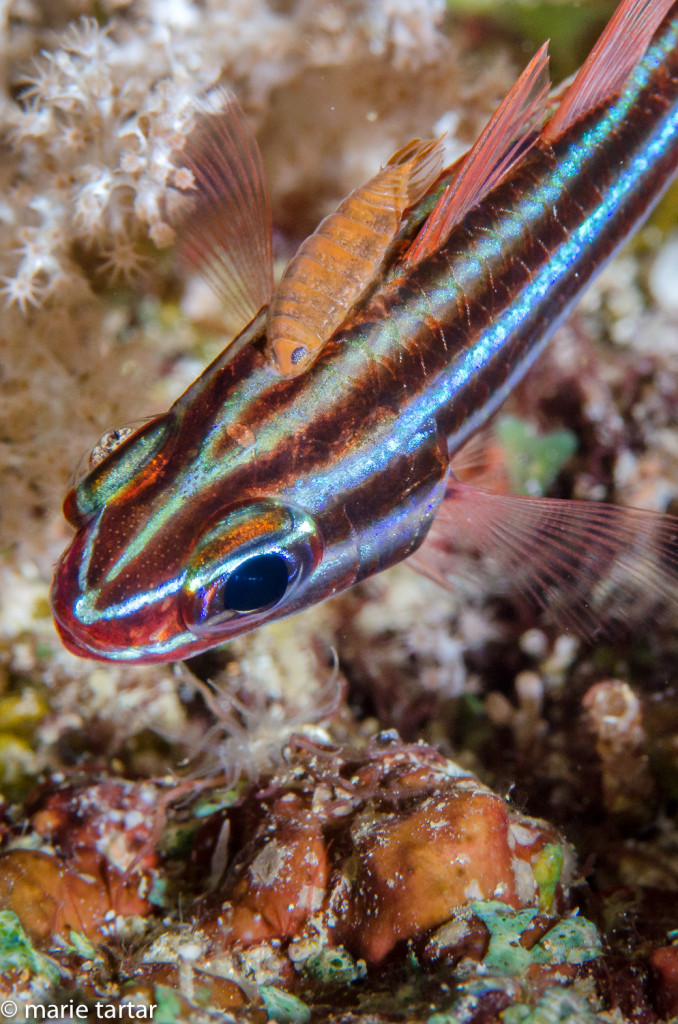
Something I love about underwater photography-the surprise of discovering “extra” animals in your shots!
Copepod on cardinalfish
Thursday, April 3 (Fiabatjet)
I brake for turtles!
First day with Nick in the lead, a lanky, laconic and drolly funny Brit. Our group dove Tank Rock, connected underwater by a ridge with Nudi Rock. He used a water bottle as a noisemaker to lure grey reef sharks out of the blue to check us out. As we sheltered from a strong current on the lee side of a shallow ridge at 20 feet, we found a pair of turtles! I happily occupied myself with a hungry feeding turtle for the rest of the dive.
That first dive set the theme for the day, as we saw turtles on every dive, including the night dive at Wutang Rock.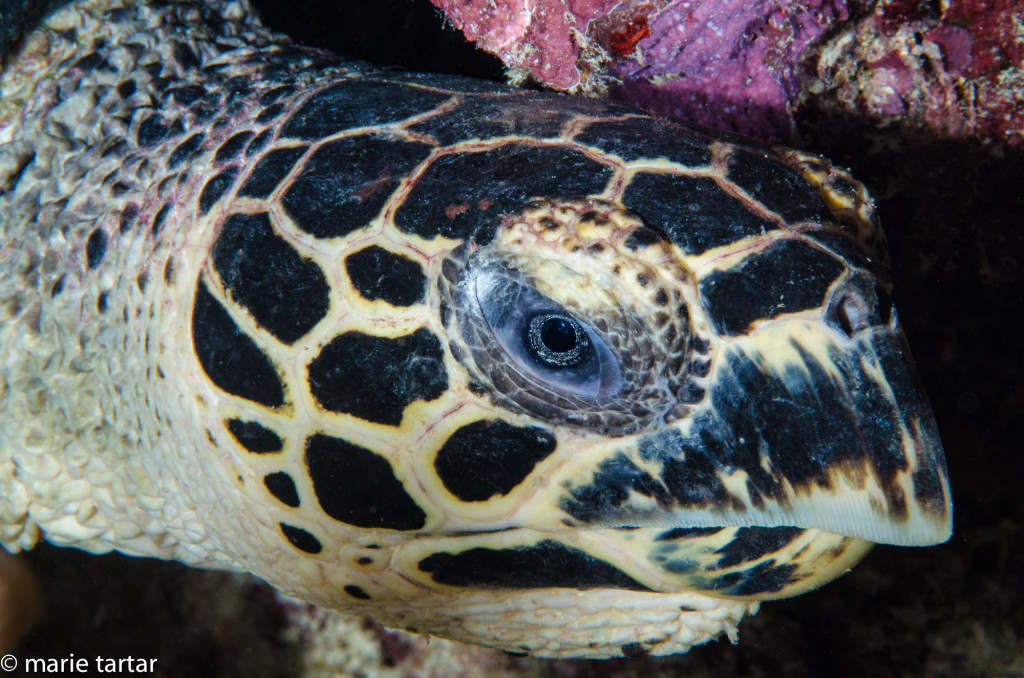 I thought this turtle had it’s head stuck in the reef, it was so deeply embedded, tearing the coral as it fed. See the video (link below) for the turtle in action!
I thought this turtle had it’s head stuck in the reef, it was so deeply embedded, tearing the coral as it fed. See the video (link below) for the turtle in action!

I thought this turtle had it’s head stuck in the reef, it was so deeply embedded, tearing the coral as it fed.
See the video (link below) for the turtle in action!
Link to turtle video: https://vimeo.com/92992497
Between the first 2 dives, we visited nearby Misool Eco-Lodge, where Shawn Henricks (see images from our “sailfish” trip with Shawn in blogpost from February 2014) showed the group around, including the capacious camera room, housing his monster rig, with 4 lights and 2 strobes. Misool is in a “no take” zone, and the dives show the results: teeming with fish, with lush soft corals and huge seafans.
Friday, April 4 (Wagil)
Warna Ribu (Johannes): Although the advice was to set up for wide angle, I decided to keep my macro set-up, given the low light level of morning. It was a beautiful site, with some current. Johannes showed Fred and me two tiny Hippocampus Denise pygmy seahorses, on a horizontally hanging fan, with no place for a right-hand shooter to hang on with the left. I should know better than to try to shot such tiny creatures under such unfavorable conditions, but always feel compelled to try. Free-hanging and macro of microscopic animals really isn’t ideal.
I should know better than to try to shot such tiny creatures under such unfavorable conditions, but always feel compelled to try. Free-hanging and macro of microscopic animals really isn’t ideal. 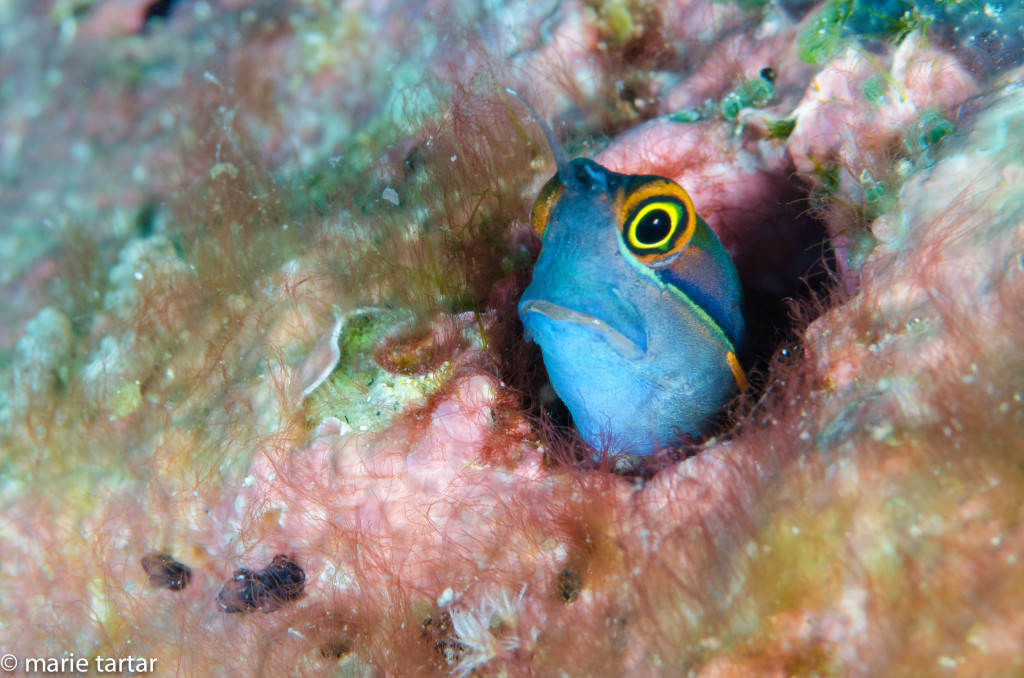 The end of this dive, through a glorious soft coral thronged arch, was a spectacular wideangle setting.
The end of this dive, through a glorious soft coral thronged arch, was a spectacular wideangle setting.
In the late afternoon, we loaded up to take a tour by speedboat of the islets, with their craggy, skin-splitting coral spires at the water’s edge, topped by surprisingly dense jungle, despite the apparent lack of topsoil, with the tall trees seeming to shoot straight out of limestone. These mushroom like tufts of islets are remnants of ancient, uplifted coral reefs.
Saturday, April 5
Awesome early (7am) dive at Boo Windows, timed to avoid a group from Misool Eco-Resort, well worth getting up early. The site is the cover of Burt Jones and Maurine Shimlock’s book Diving Indonesia’s Raja Ampat, with a set of holes in the shallows. We took turns swimming through the apertures.
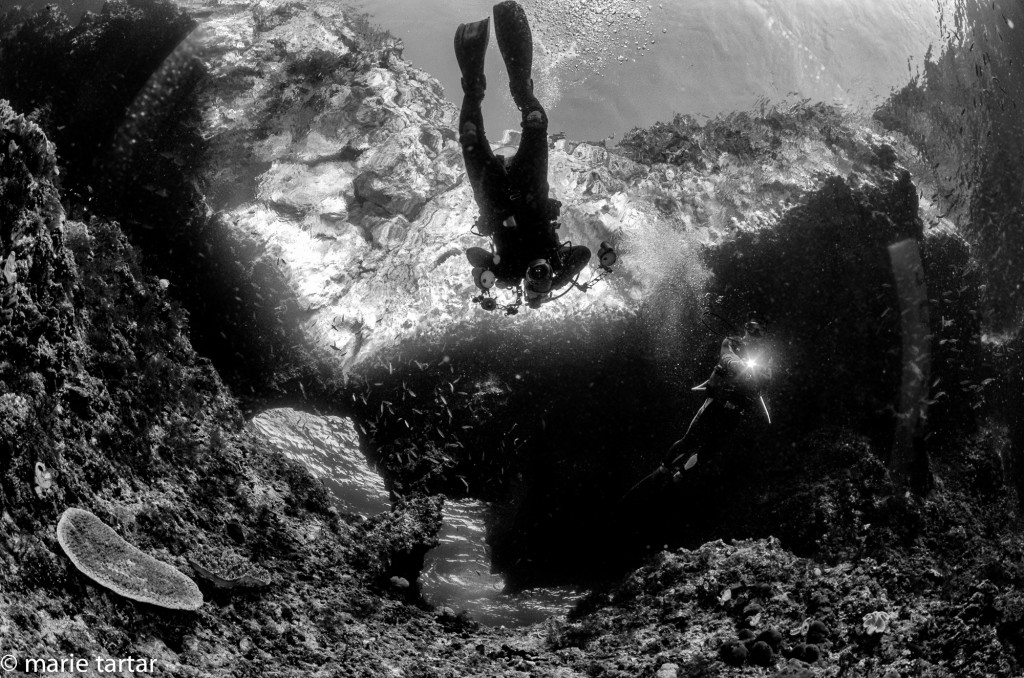
Through the windows the divers come and go. Talking of Michelangelo.
(with apologies to T.S. Eliot, The Love Song of J. Alfred Prufrock)
In the channel between islands (one a picturesque lone tree islet), schools of fish faced into the current, which thankfully, wasn’t so strong that we couldn’t swim out into the blue. I saw Jake out there and as I approached, the grey cloud next to him resolved into the biggest school of batfish I have ever seen, much less swam with or shot.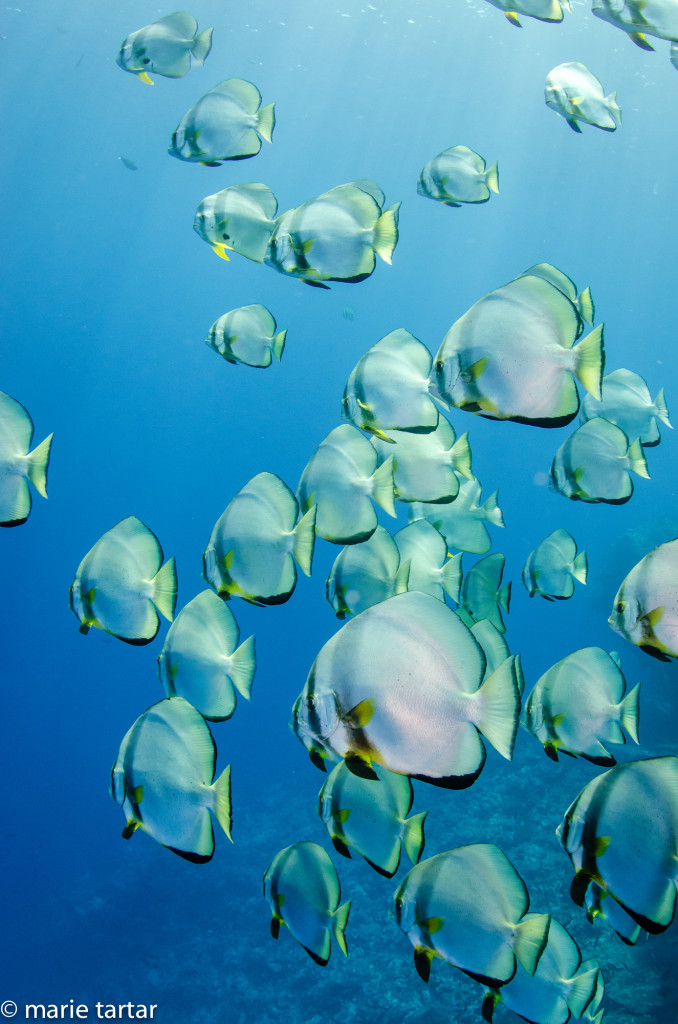 There was so much fish activity, I almost wasn’t interested when Ivan pointed out a turtle on a bommie, shredding a coral as he tore into it, munching away, clouds of mucous and meal debris shrouding his beak.
There was so much fish activity, I almost wasn’t interested when Ivan pointed out a turtle on a bommie, shredding a coral as he tore into it, munching away, clouds of mucous and meal debris shrouding his beak.
Magic Mountain (Gunung Ajaib, near Warakaraket Island) lived up to its name. We were split up in 3 staggered groups, ours being first. Although our group, as the first to go, missed the oceanic manta which graced the second group with flybys, we still had an epic dive. 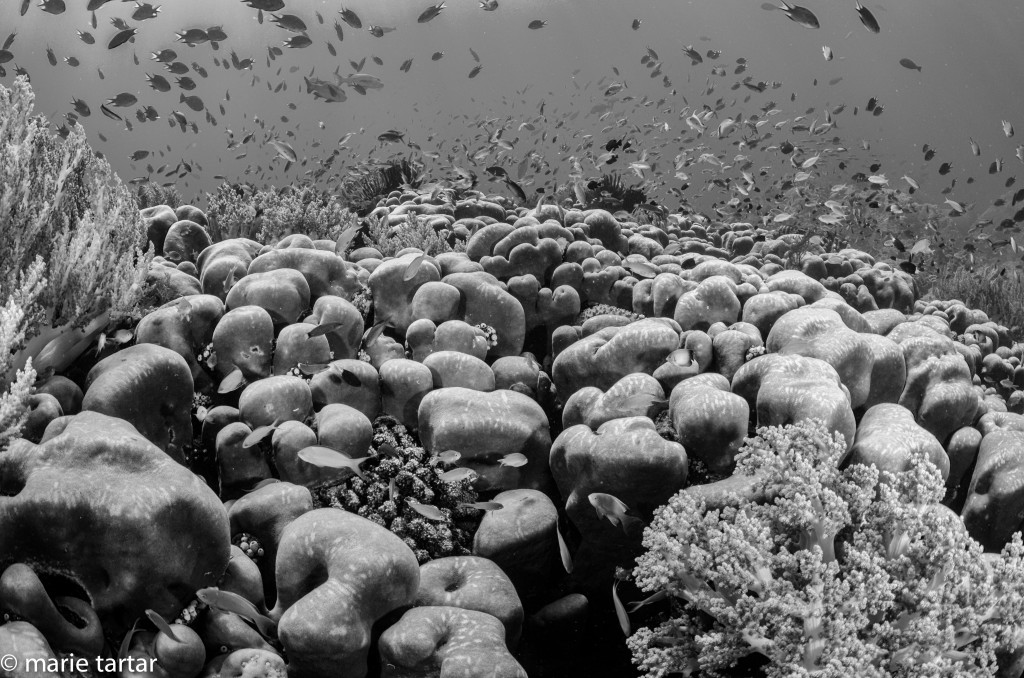
The site became more and more active with fish schools, with clouds of fusiliers, and batfish hanging at 30 feet. 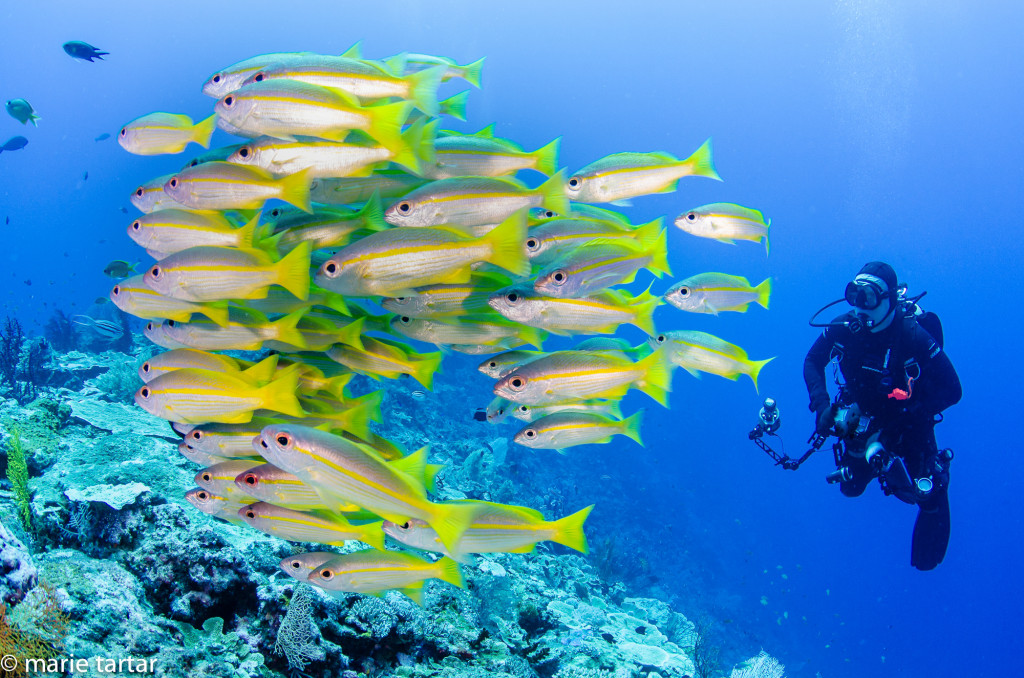 A baby grey reef shark, somewhat battered in appearance, patrolled the area, but wasn’t particularly approachable. However, it’s larger cousin, being cleaned on the bottom, tolerated reasonably close approach.
A baby grey reef shark, somewhat battered in appearance, patrolled the area, but wasn’t particularly approachable. However, it’s larger cousin, being cleaned on the bottom, tolerated reasonably close approach.
In the afternoon, the entire group headed back en masse. Returning to the point, we hoped for a return manta sighting, but to no avail. However, this site is truly an embarrassment of riches. My head spinning, I wasn’t sure what to focus on first.
Swirls of fishes overhead and in the blue on either side of the ridge connecting the plateau to the point, small reef sharks circling, giant Napolean wrasse seeming to lumber past, yet still often evading close approach. Toward the end of the dive, I asked Johannes to show me where the previously sighted wobbegong shark was. He showed me two, one just a tail protruding from under a ledge, the other a short swim away, at 38 foot depth. We later enjoyed Mark’s video of the wobbegong in motion (swimming a few feet to dive under the ledge is what passes for action with this rather sendentary animal).
Sunday, April 6
We motored all night to reach Koon. Our first 2 dives were mirror images of each other, a slope dotted with coral bommies, ending in bright white sand. Nick said at times a huge school of batfish could be found here, and I caught a brief glimpse of them at depth while reboarding the skiff after the first dive. Steve did get to swim with them, alerted by Nick banging his tank while he was already on his safety stop. I found myself shooting scenics, fish posing while being cleaned.
The third dive went somewhat awry. Since our first 2 had been essentially the same profile, Nick proposed starting from the other end, warning us that the current likely would have picked up speed. When he did our pre-entry scouting on site, he returned with “it’s really pumping.”
Steve elected to jump in with the camera, set-up for wide angle, with Fred’s 12-24 mm lens, despite my discouragement. After we entered, we found ourselves in 5 feet of water, with small corals studding the sand. After a few minutes, Nick and Fred were not to be seen. I thought Steve was still behind me, while I swept along in visual range of Kevin and Jake. It was really unclear whether our passage would lead us to more promising territory. I could see a slightly deeper area off to my right, which proved to be about 15-20 feet in depth. A mammoth barracuda, the biggest I’ve ever seen, caught my attention and I was able to divert my course just enough to end up in this area, which was thronged with fish, including a small group of batfish, and dueling silver triangular pompano fish, which sliced their way through the water with dramatic thrusts. 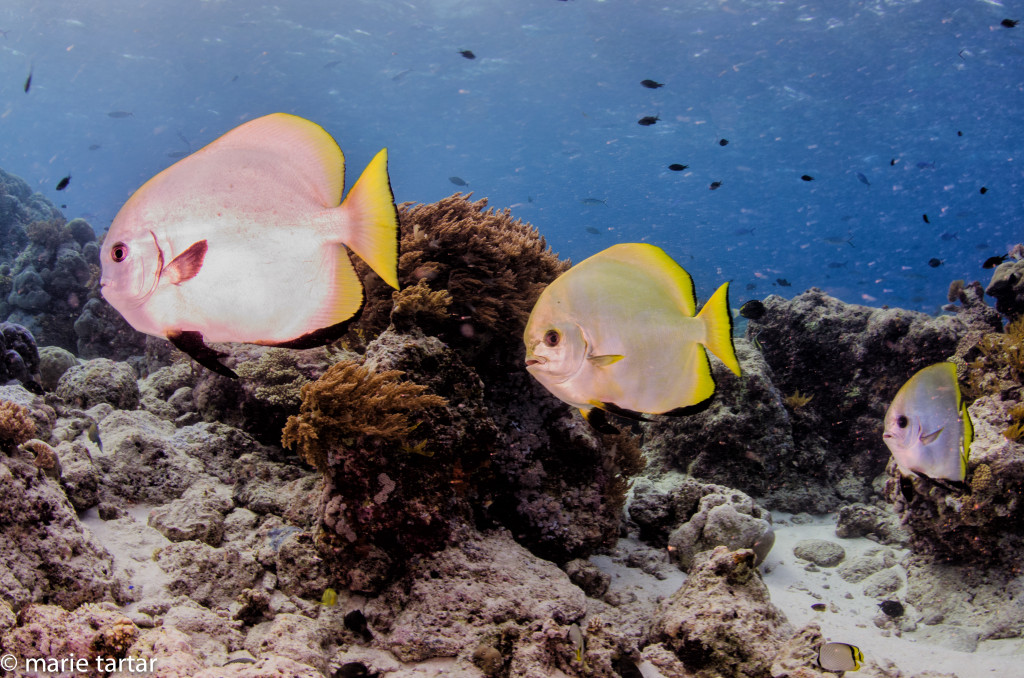 There were intermittent extremely strong gusts of current, so strong I couldn’t even bring the camera around in front of me. Even hanging on to a rock was difficult. By this time, it was clear I was completely alone, which itself doesn’t bother me, as long as I know the area, and have some knowledge where a current might carry me. This not being the case, I elected to bail after a few minutes, lest I be swept away out of visual range, behind an island. As I was being picked up, I could see someone in the distance projecting well above the water level, being picked up by another speedboat. I was surprised once back on the Pindito to realize it was Steve, returning early, having flooded his camera. He was shooting an eel in hole and pulling back out, caught the dome port and then saw water in it. The puffed up diver I saw on the surface was him, having hyperinflated his BCD, trying to keep the camera above his head.
There were intermittent extremely strong gusts of current, so strong I couldn’t even bring the camera around in front of me. Even hanging on to a rock was difficult. By this time, it was clear I was completely alone, which itself doesn’t bother me, as long as I know the area, and have some knowledge where a current might carry me. This not being the case, I elected to bail after a few minutes, lest I be swept away out of visual range, behind an island. As I was being picked up, I could see someone in the distance projecting well above the water level, being picked up by another speedboat. I was surprised once back on the Pindito to realize it was Steve, returning early, having flooded his camera. He was shooting an eel in hole and pulling back out, caught the dome port and then saw water in it. The puffed up diver I saw on the surface was him, having hyperinflated his BCD, trying to keep the camera above his head.
Monday, April 7, 2014
We were in transit all night, into the morning, heading southwest to the Banda Neira region (Banda Islands, aka Spice Islands), encountering the first rocking of the trip, as well as clouds and rain. Our passage delayed by winds, we watched a BBC documentary on the Spice Islands, called Nutmeg and Cloves, after breakfast. The history of this region is fascinating. European explorers journeyed vast distances in order to obtain nutmeg, building fortunes while subjugating and brutalizing the local people. (A bag of nutmeg, worth more than gold, could buy a house in London!) The Dutch and the English were competitors for the nutmeg trade, with the Dutch dominating, under the direction of a vicious man named Jan Pieterzoon Coen, who slaughtered 44 sultans. Under his direction, 90% of the local people were killed, enslaved or fled. The English ended up with one island, Rhun, their first colony, which was later exchanged to the Dutch in return for keeping New Amsterdam, which they had captured from the Dutch. It is quite extraordinary to think how the course of history was set on new courses by such negotiations. New Amsterdam, of course, is better known today as New York.
Our group of lefties headed with Johannes to Ship Rock, an underwater formation shaped like the prow of a ship. As we descended, we could see the formation shrouded with clouds of fish. I had thought there had been an amazing number of redtooth triggerfish (Odonus niger) on the prior day’s dive, but that was nothing compared to the clouds present here. Pyramid butterflyfish (Hemitaurichthys polyepis) were astonishingly numerous as well, even pausing on a large flat coral, presumably being cleaned. Johannes pointed out a pair of small eels protruding from the wall, and I found a mismatched larger pair close by. We swam over a sand channel to a more shallow secondary pinnacle for our safety stop, where I succeeded in white balancing prior to shooting some video. The clouds of fish darkening the water column brought Alfred Hitchcock’s “The Birds” to mind. Related video at: https://vimeo.com/93050774
Our second dive featured a swim-through tunnel, studded with large fans and barrel sponges, at about 90 feet depth. It would be gorgeous to shoot, but the current pushed us through so rapidly there really wasn’t time to compose. On the other side, the current picked up strength, until we were swept to the end of the formation, where we could gain some cover and recover, prior to ascending slowly. This site was also covered with fish, especially redtooth triggers and pyramid butterfly fish.
We sailed into the harbor at Banda Neira in late afternoon, a pretty sight, with the lush forest covered volcano towering over the capital, a line of pastel Dutch colonial style houses on the waterfront.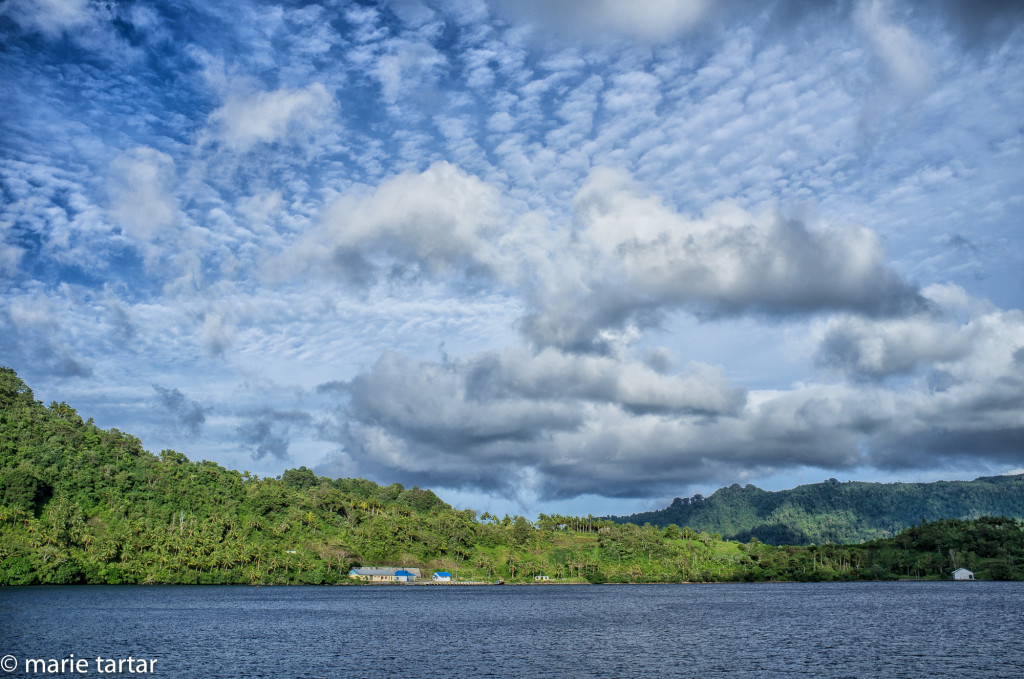 Our last dive of the day was timed for mandarin fish sightings, and hopefully mating. The creepy-crawly fishes were there, in abundance, hopping on rocks in the shallows in front of a waterfront hotel.
Our last dive of the day was timed for mandarin fish sightings, and hopefully mating. The creepy-crawly fishes were there, in abundance, hopping on rocks in the shallows in front of a waterfront hotel.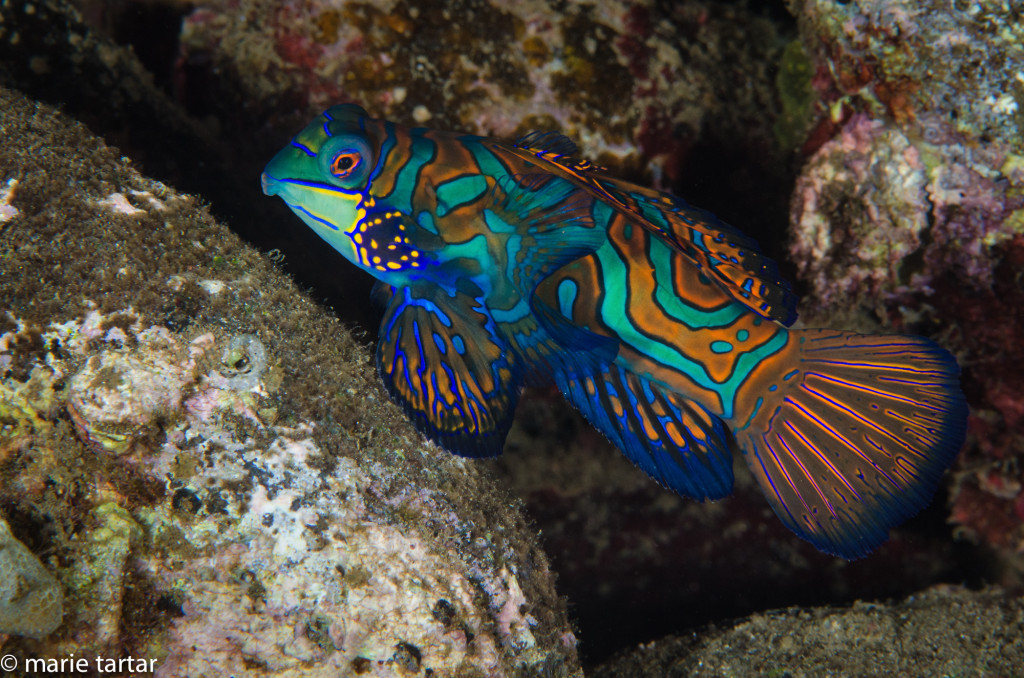 Although not tiny or difficult to see, they proved to be surprisingly difficult to shoot. They are shy, so we used red lights. As soon as I had one in my sights, willing it to turn around, either it would duck under a rock or my mask would flood. Or both. Eventually, I prevailed, at least improving on my abysmal track record with this particular animal (this would be my 3rd dedicated attempt, the first two being complete wash-outs, both in Lembeh Strait), obtaining reasonable portraits.
Although not tiny or difficult to see, they proved to be surprisingly difficult to shoot. They are shy, so we used red lights. As soon as I had one in my sights, willing it to turn around, either it would duck under a rock or my mask would flood. Or both. Eventually, I prevailed, at least improving on my abysmal track record with this particular animal (this would be my 3rd dedicated attempt, the first two being complete wash-outs, both in Lembeh Strait), obtaining reasonable portraits. As it turned out, no one else had a mating pair either. Maybe there was too much company for romance with all of us looking on eagerly.
As it turned out, no one else had a mating pair either. Maybe there was too much company for romance with all of us looking on eagerly.
There were more surprises in store a little deeper and further down from the hotel. I “found” a pair of yellow frogfishes on an I beam.  Of course, I had spent so long with the mandarin fishes that I was late to the party. The frogfishes had, of course, been discovered much earlier in the evening and had already been much photographed.
Of course, I had spent so long with the mandarin fishes that I was late to the party. The frogfishes had, of course, been discovered much earlier in the evening and had already been much photographed.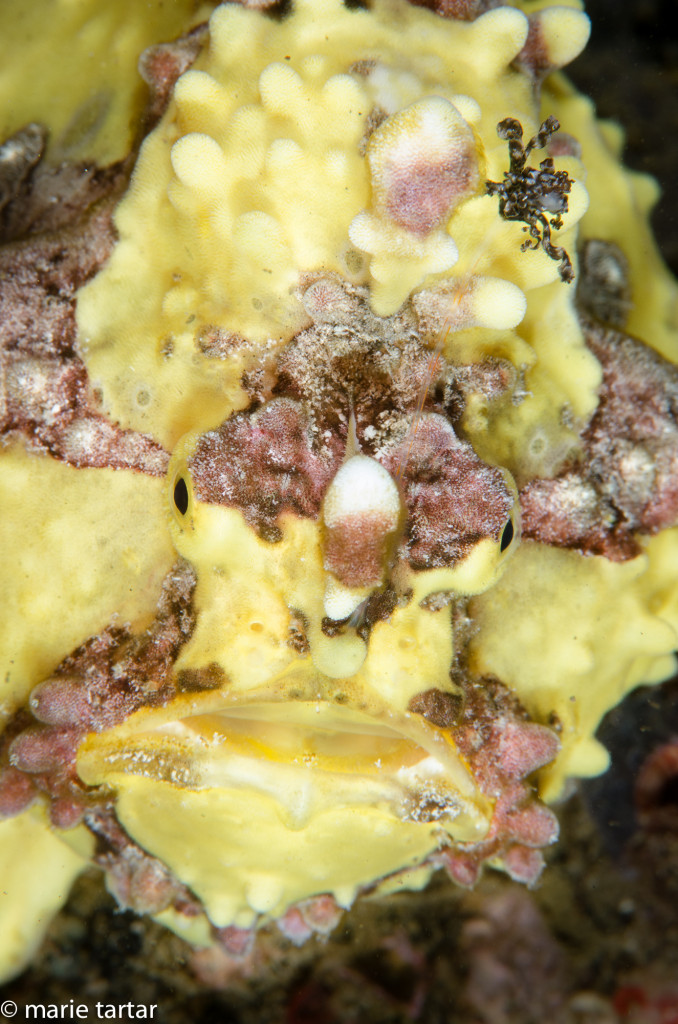
I saw more cuttlefish on this dive than on the entire trip put together, including a pair in 69 position, maybe mating, with dark tentacles, and another individual or two (maybe the same one reappearing?).  The pair split up, diving under rocks. I thought I was following one of them, noticing as I shot it that it had unusually dark tentacles. Or so I thought. When I reviewed the images later, I discovered the “dark tentacles” actually were the fins of a poor devoured damselfish, hanging from the cuttlefish’s mouth.
The pair split up, diving under rocks. I thought I was following one of them, noticing as I shot it that it had unusually dark tentacles. Or so I thought. When I reviewed the images later, I discovered the “dark tentacles” actually were the fins of a poor devoured damselfish, hanging from the cuttlefish’s mouth.
Dinner this evening was highlighted by a candle-crowned birthday cake for Joanna, turning 34 years old on this day.
Tuesday, April 8, 2014 (Banda Neira)
The day started very early, in the dark, with a 4:30 am wake up knock, for those, including me, Mark, Joanna, Donnie, Kevin, Joel, Erin, and Tim, opting for a hike up the volcano which dominates this setting. It’s Indonesian name is a common one for volcanoes: Fire Mountain. It last erupted in 1988, leaving a black swath across one flank, decimating the coral reef off-shore.
The rest of the volcano is covered with lush vegetation. We picked up 2 guides to accompany us, and headed up. Johannes had said the hike was “strenuous” and slippery and that he had never made it without at least once ending up on his “bum.” He was not exaggerating. My legs were thrashed later the same day trying to fin when diving the lava flow area.
We lucked out with the conditions, being relatively cool and cloudy. The first part wasn’t bad, just steamy and indeed strenuous. Just after the hut, perhaps 1/5 of the way up, Mark peeled off, having vertiginous symptoms. The rest of us carried on, as the trail became increasingly steep, and in sections, near vertical, requiring holding on to trees, roots and palm fronds. One of the guides, in flipflops, took my hand in key sections and was instrumental in steadying me on the even more treacherous descent. Descending was like walking in snow, collapsing under your feet at each step, or skiing on sliding crushed volcanic skree. Except that snow is usually soft, unlike this unforgiving terrain.
Scratched, dirty and soaking wet from a rainstorm that erupted at the top, our bedraggled bunch returned to find the non-hikers at their second breakfast, after diving the lava flow. The hiking group headed there after rinsing off, fully clothed, in the outdoor shower. My light grey shorts, chosen because they were already dirty, were now black with dirt, from scootching down on my rear on the more sketchy sections. I had my favorite Indonesian breakfast, fried rice, as reward for the hike, leftover from dinner the night before and specially requested.
The lava flow dive is named Hard Coral Heaven, and indeed, it is an astonishing array of large and varied hard corals, and remarkable to imagine this springing anew from the ocean in 26 years since the volcano erupted. I found a large eel, being cleaned by a spritely striped cleaner wrasse, even inside the mouth.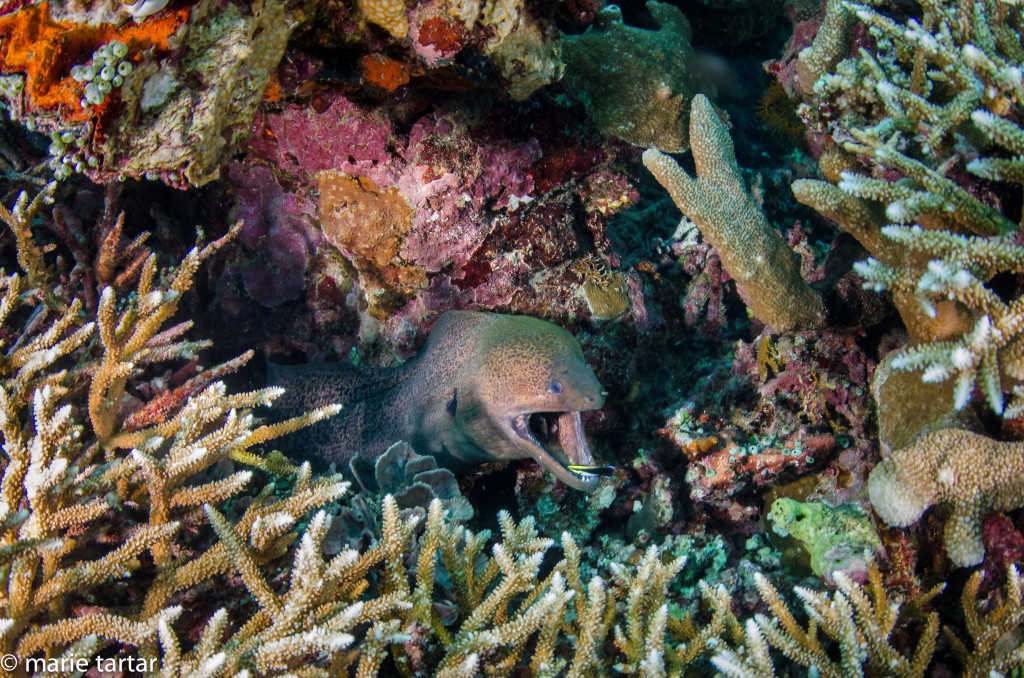 To see the wrasse in action, here’s a link to a video segment: https://vimeo.com/93099455
To see the wrasse in action, here’s a link to a video segment: https://vimeo.com/93099455
Thankfully, there wasn’t much current to contend with, as my legs were totally spent by the hike.
In the afternoon, we had the option of doing a harbor dive, the scene of our prior night dive, or going into town to see the museum, the old Dutch fort and the fish market. Everyone opted to head into town, an interesting mix of small shops, Dutch colonial buildings and friendly locals. The local star of the documentary on the Spice Islands we saw the other morning took us through the museum, which features a painting highlighted in the film, showing Japanese mercenaries beheading the local chiefs, at the behest of the Dutch colonists.
Wednesday, April 9, 2014
Our last full day of diving on Pindito began with first breakfast merging into second, as we inched our way closer to Ambon. We dove Nusa Luat all day. I spent the first half of our first dive doing wideangle portraits of angular and sculptural sponges, then was thrilled to find a cooperative trumpetfish under a beautiful lacy table coral.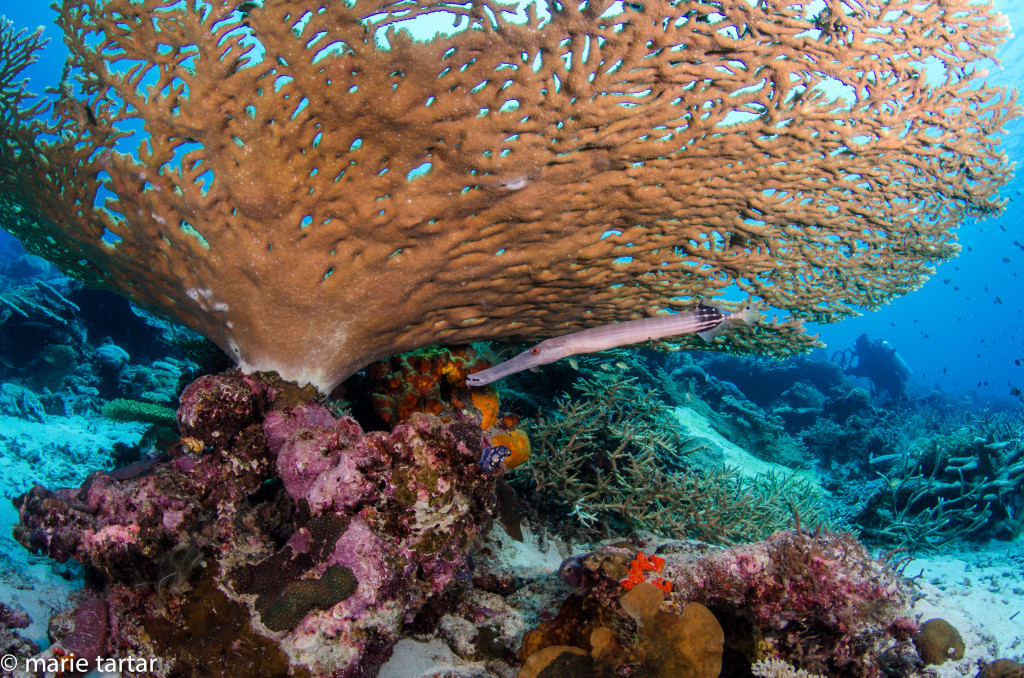 On the second dive, the current picked up me and Kevin from our depth of 55-60 feet, sweeping us into an extensive expanse of sand, with no colorful shallows to work up to, so we were forced to ascend in blue water above the reef.
On the second dive, the current picked up me and Kevin from our depth of 55-60 feet, sweeping us into an extensive expanse of sand, with no colorful shallows to work up to, so we were forced to ascend in blue water above the reef.
On the night dive, I made the unhappy discovery that my 105 macro lens seemed to be set on “limit,” effectively forcing me to choose larger subjects and preventing me from focusing as close as usual. The colorful mantle of a small giant clam (Tridacna ) and a lionfish on a hard coral worked with this set-up, but I couldn’t even make out with my eyes a microscopic blob of an algea shrimp shown to me by Iwan, much less focus close enough to make something of it photographically.
Thursday, April 10, 2014
Our last day on Pindito was an action packed one, starting with 2 muck dives in the harbor at Ambon, and finishing with a celebratory send-off dinner, Indonesian style, after Johannes introduced the crew and a new arrival, boat owner Edi. The day also brought Christmas in April to Joel, who had been left hobbled photographically by his D800E, whose on-camera flash refused to fire, necessary to trigger his strobes. Even master of ingenuity Fred couldn’t rig up a work-around, and Joel was forced the entire trip to use a battery of Sola lights to light his subjects. He did a remarkable job under the circumstances, as we saw later that evening. Johannes and Edi had arranged to have a new camera body flown out to meet us in Ambon, and on our final morning, it arrived in time for Joel to use it, as well as to try it out prior to his extended stay afterwards in Ambon.
The lefties spent the first dive with Johannes at the “Twilight Zone,” essentially under and in front of a line of colorful turquoise and red fishing boats in the harbor. He implied the name stemmed from the weird array of crazy muck-dwelling creatures to be found in the depths, but the name took on addition significance to me underwater, as we found ourselves blasted by horrendous noise and vibration of some nearby mechanical monster. I had been struck earlier that morning by how close the airport was and how horribly a departing jet rent the calm of the early morning in Ambon. My first thought as the underwater aural assault began was that another plane must be taking off. But the noise persisted without ceasing, and after surfacing later, realized it probably was the generator of one of the fishing boats near-by, or possibly the departing Damai 1, which had been anchored nearby when we first entered. Altogether, it was a terrible experience, and really distracted from what seemed to be a rival for Lembeh in terms of muck diving productivity. Like Lembeh, the water was often quite milky and visibility limited, with the rest of the group and Johannes disappearing quickly if one stopped to investigate a potential subject along the way. A snake eel, banded and spotted in grey and brown, was out of the sand as we entered, and I quickly lost the group as I stayed behind to watch it ferociously work it’s way back into full concealment of it’s long body under the sand. There were many eels to be found, including one of the prettier specimens, the snowflake eel. I also braked for anemone crabs, picking their way deliberately through the rubble.
The final dive was also virtually solo for me, after the first few minutes, although I was accompanied by a pair of porcelain crabs, and a blue and yellow adult ribbon eel, waving in the current from it’s hole in the reef, a colorful send-off for a fun, relaxing and stimulating Indonesian coral reef excursion.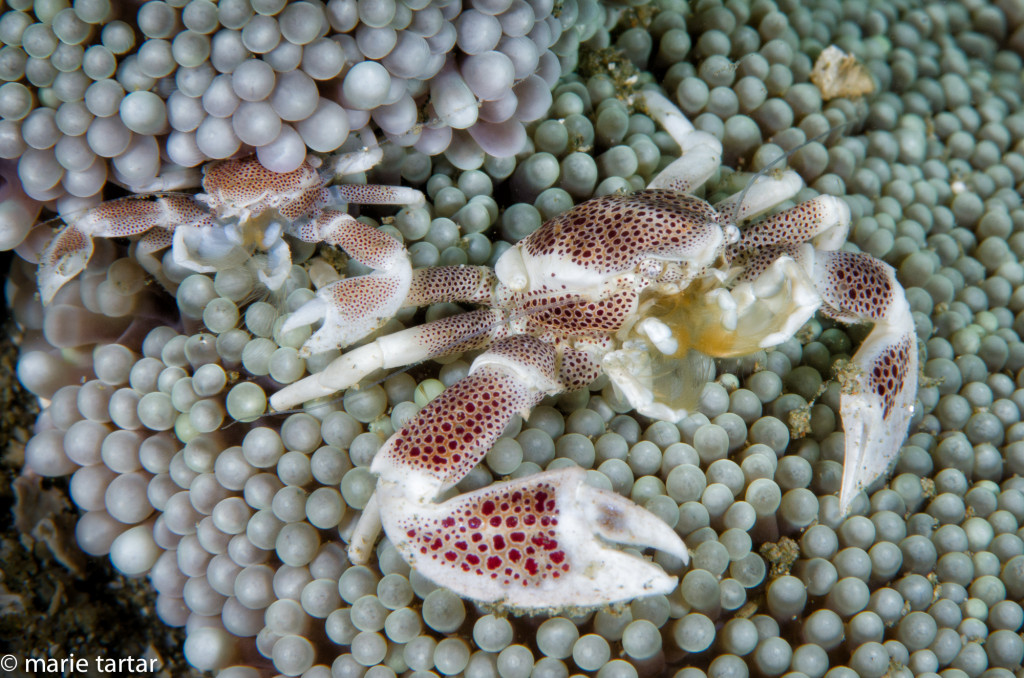
The afternoon was the usual breaking-apart-camera-systems, dive-gear-rinsing, and wrestling-bits-of-gear-strewn-all-over-the boat into orderly, checkable gear bags frenzy that marks the end of a live-aboard dive trip. The gin was exhausted by late afternoon, and somehow it all fell into place again.
The Indonesian specialty dinner was sumptuous, and kicked off by the ceremonial lopping off of the head of a leaf-wrapped cone of saffron rice by a guest of honor. Johannes selected Donnie, which seemed fitting, given his larger than life personality. There was an array of colorful dishes on a low table, including a Malaysian specialty, carmelized beef, and coconut rice. Despite our vows to throttle back on the eating now that the exertion of diving was at an end, it was so delicious, we had to have seconds.
After dinner, we had a slide show by most of the photographers shooting during the week, with the grand finale being Steve Chen’s terrific and quite distinctive black and white portraits of the guests and crew. Finally, Edi narrated his video on the hand-building in dry dock of the Pindito in 1991-2, which sent us off to bed for a short sleep before rousing at dawn for our early flight to Jakarta. Iwan and Johannes had paved the way for us, taking our checked luggage to the airport earlier and negotiating our overweight baggage fees down to a reasonable $46 for the 2 of us (vs. $230 for the 2 of us on our way in!).
Departure day is always a bit of a blur, and ours started very early, 4 am to be exact, in order to get our bags to be checked in up on deck by 4:30 am. It was worth it though, to not have to deal ourselves with the hassle of checking in, paying overweight bag fees, etc. Our return to Jakarta was more streamlined than our 3 flight hopscotch from island to island coming-nonstop, 2 hours and 2 time zone changes, pretty painless.
To ease our transition back to civilian life off the boat, I had arranged a half-day tour, complete with airport pick-up and hotel drop-off, through Tours By Locals. We spent an enjoyable day with Farid Mardhiyanto and his driver and friend Candha, who picked us up at Jakarta Airport. We felt instantly comfortable in their capable hands. They accompanied us to the signature sights of Jakarta, including the Old Town and working port, Batavia and the history museum, MONAS and the Grand Mosque, the subject of a future post.
ayarathaicuisine.com (can order to go or for delivery) 6245 West 87th Street; 90045 (310) 410-8848

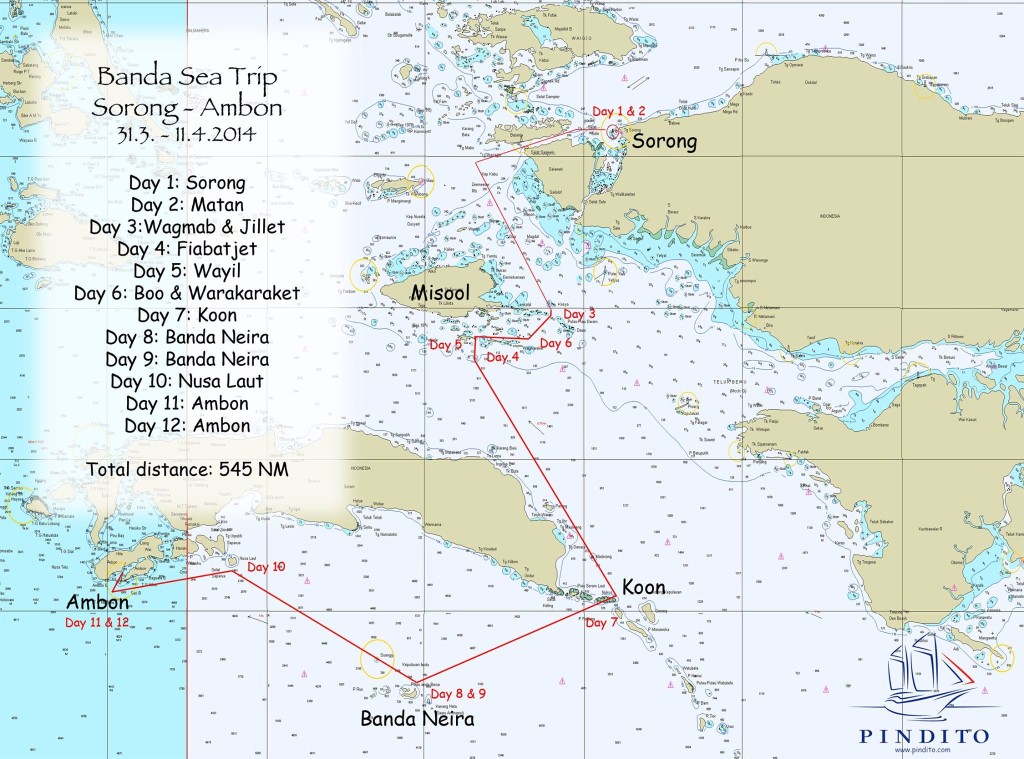
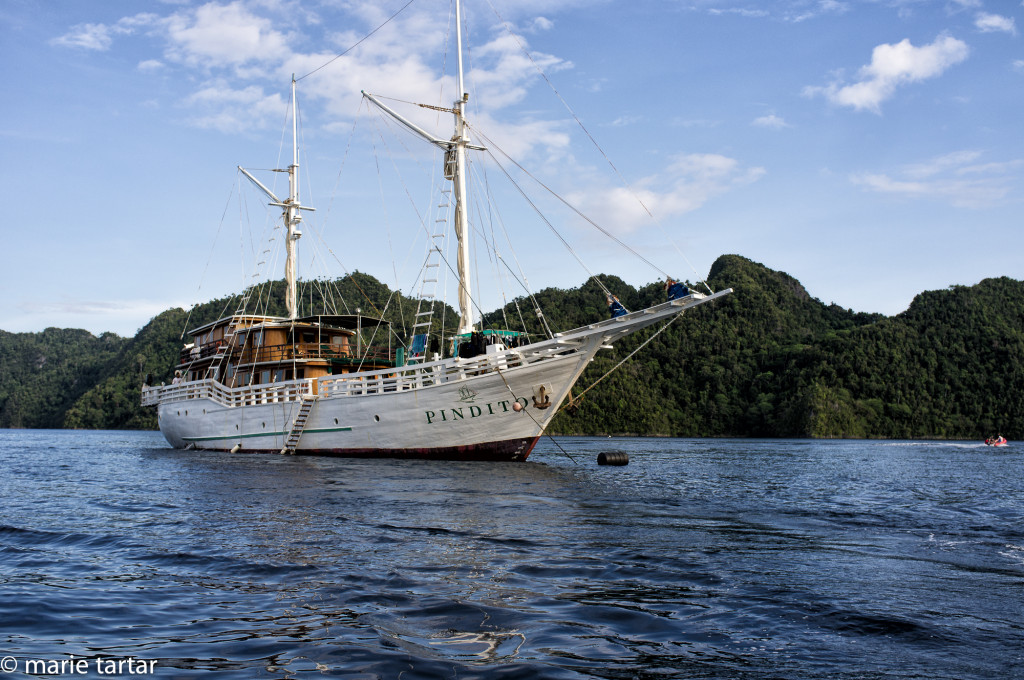

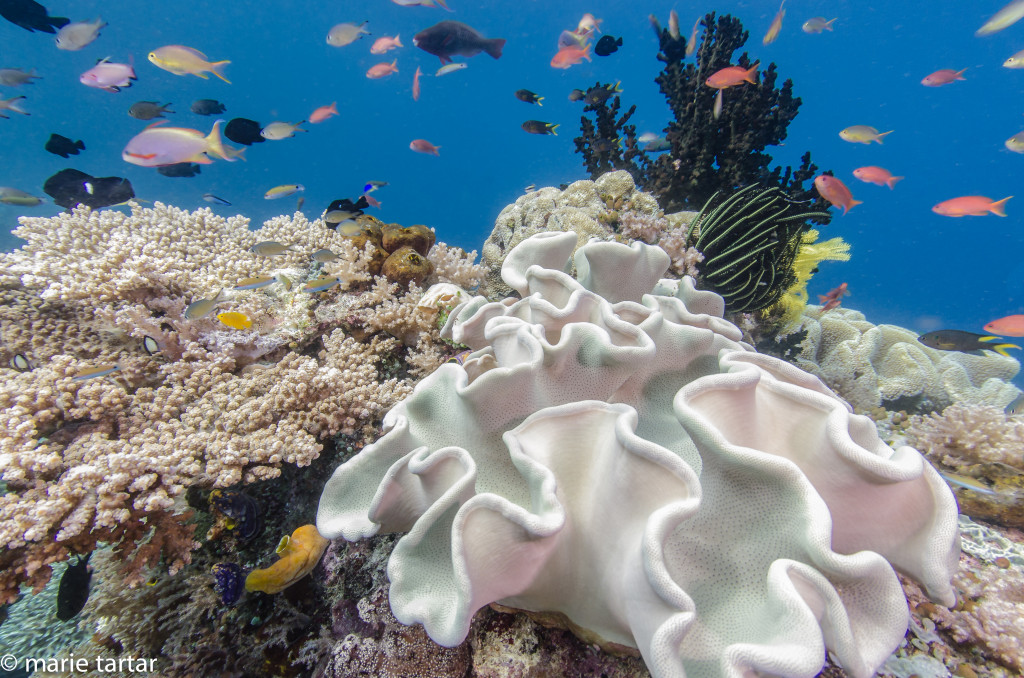

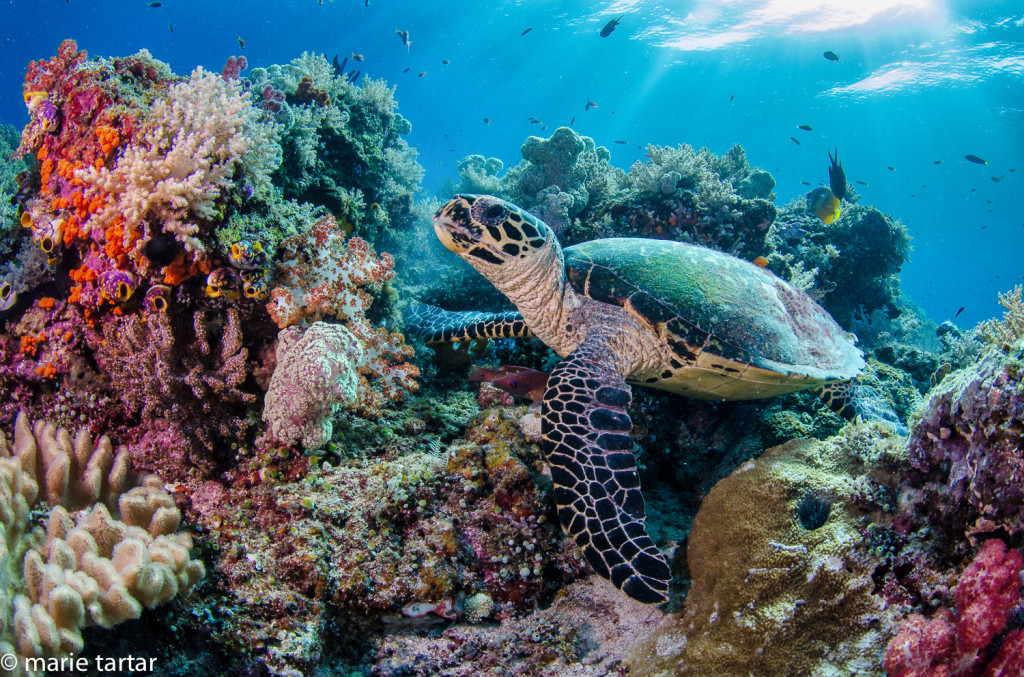

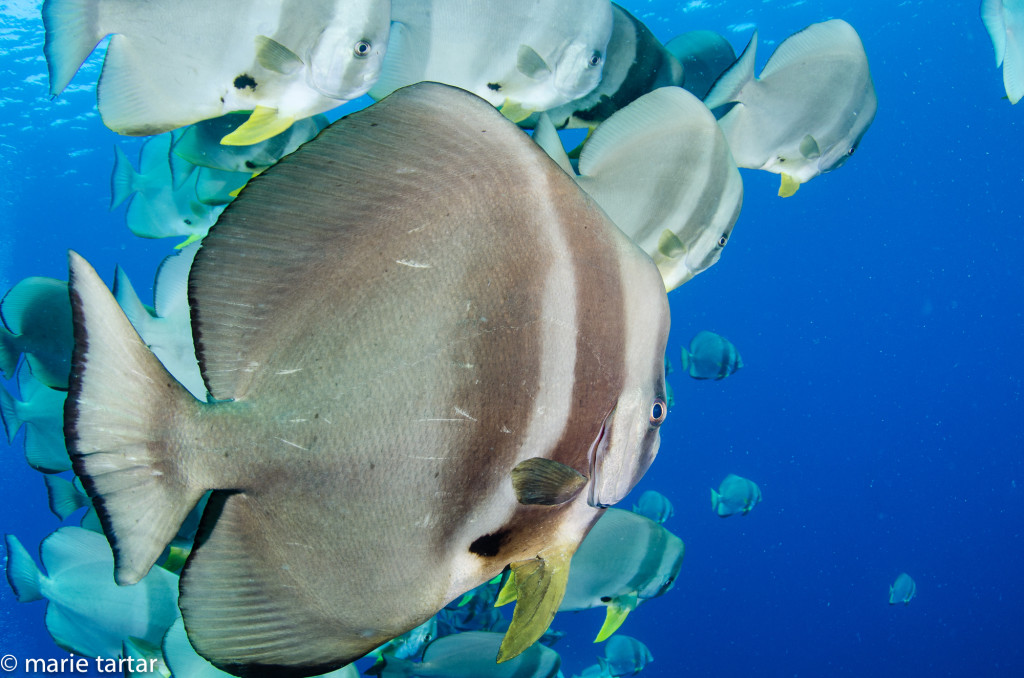
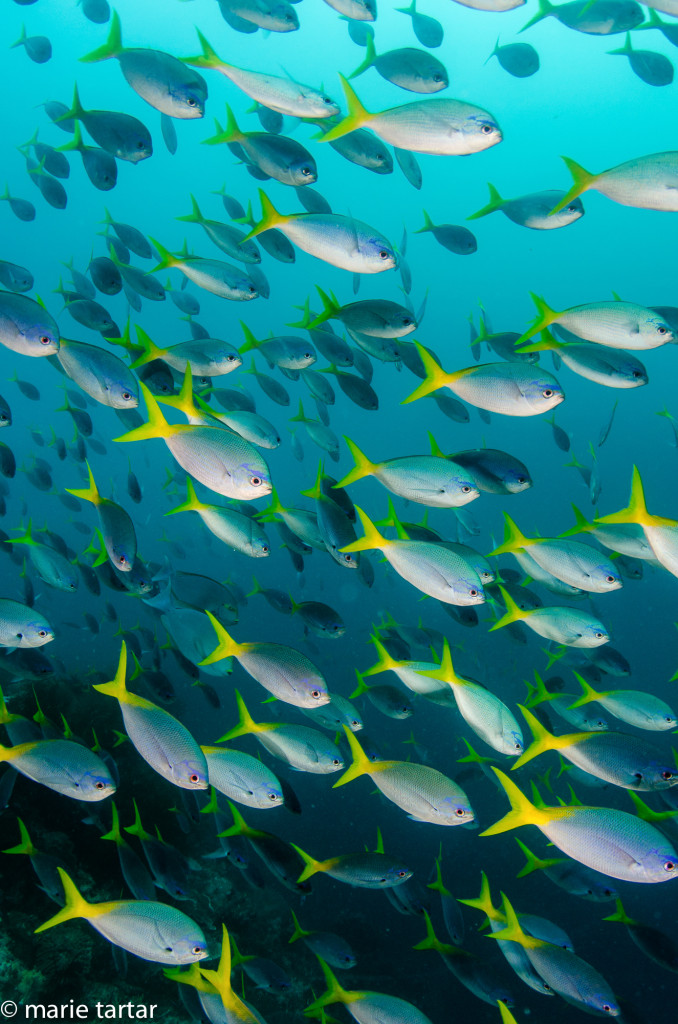


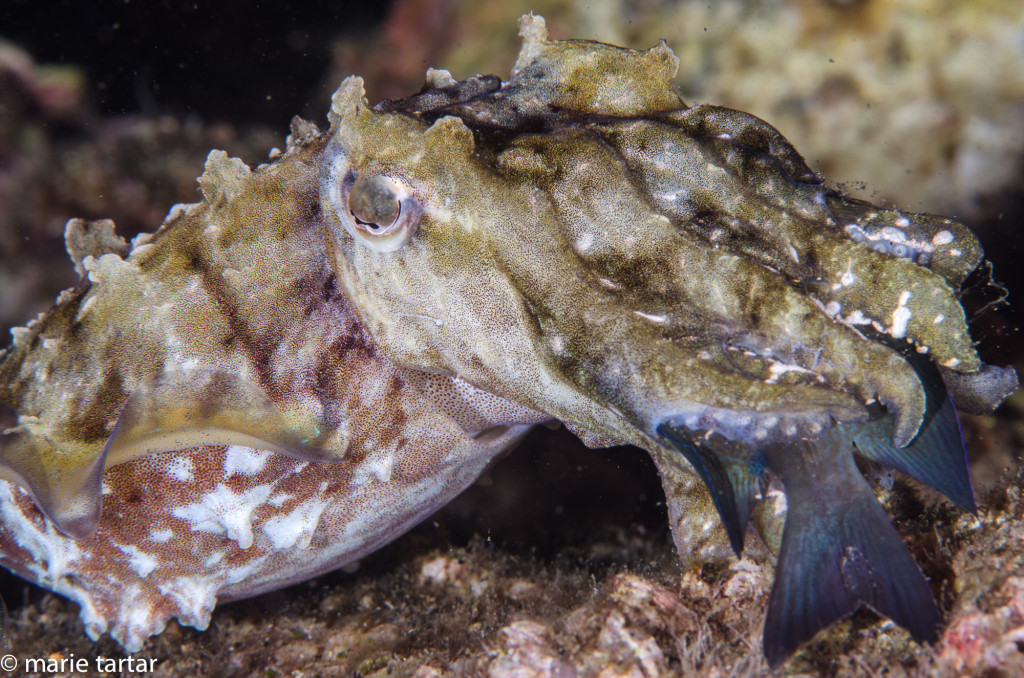
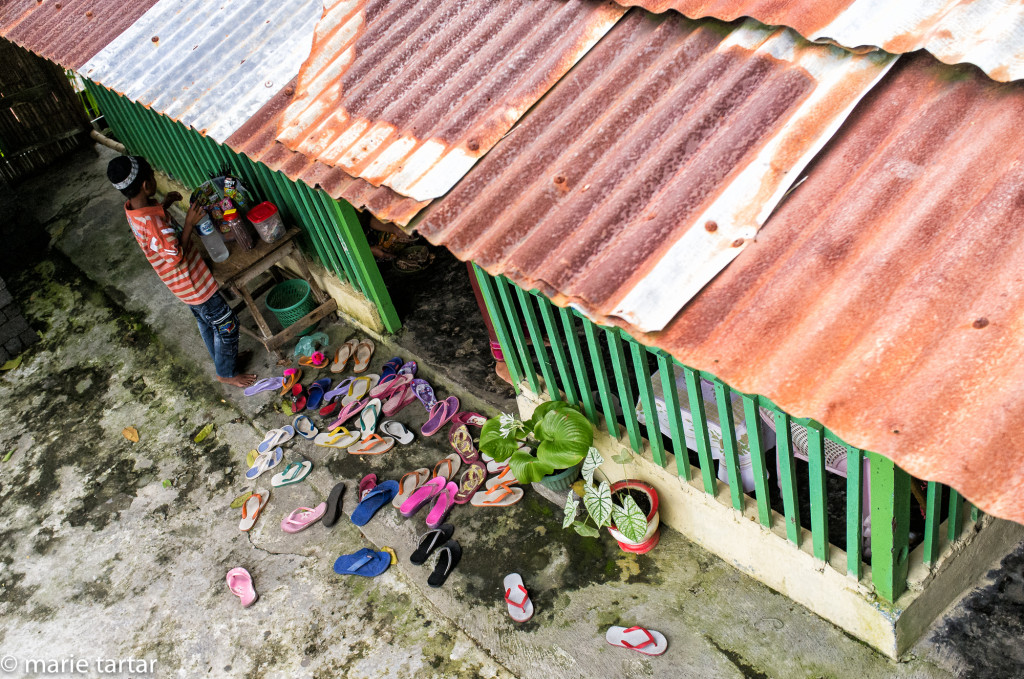
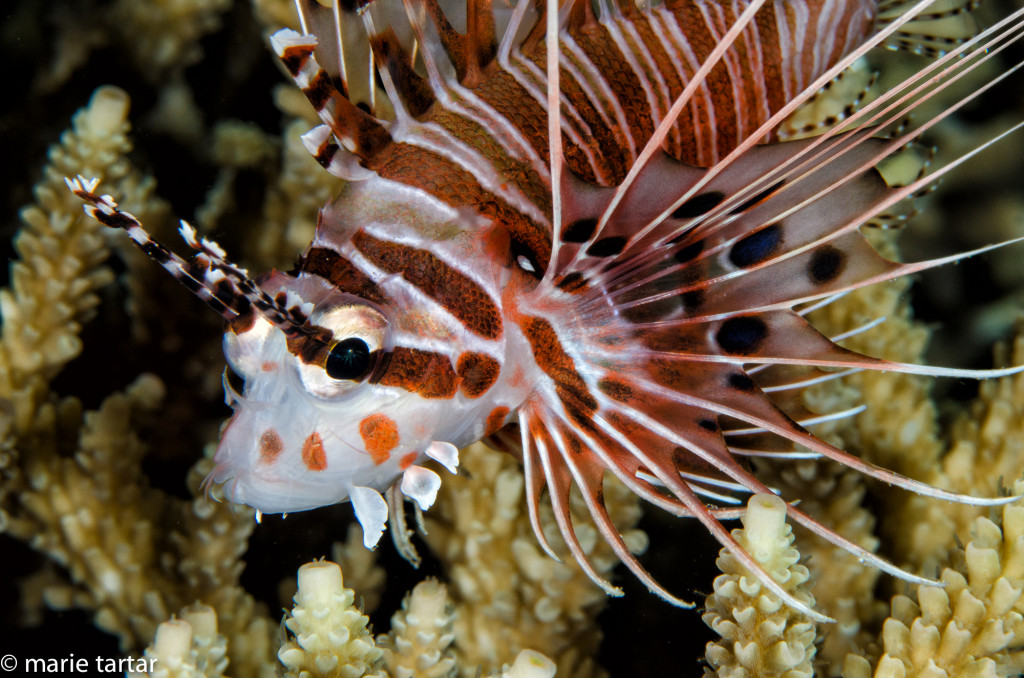

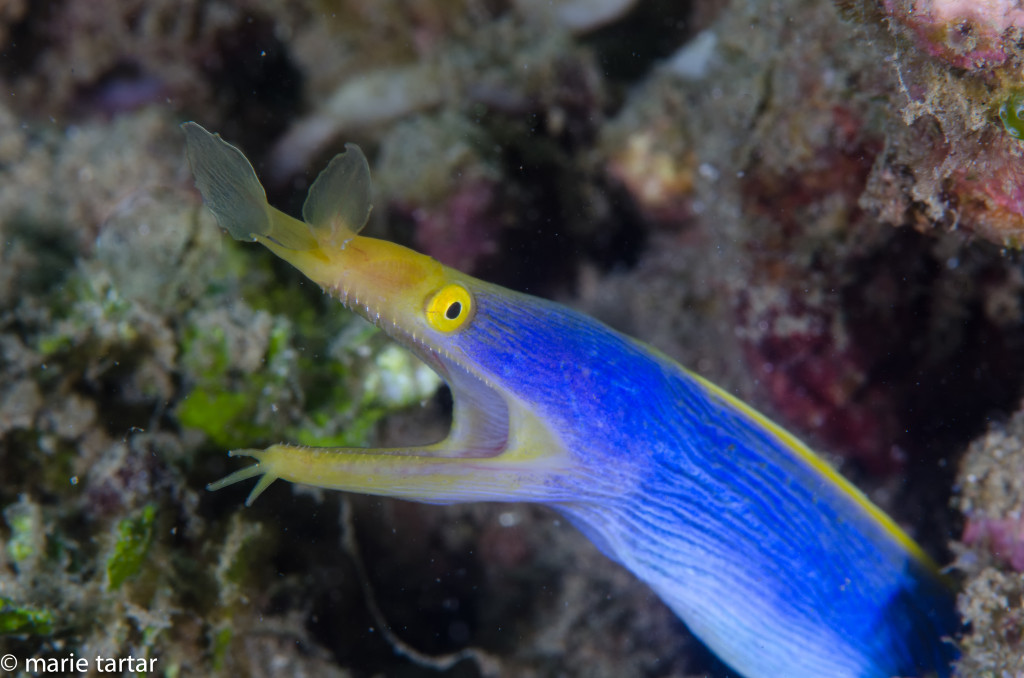
beautiful work, marie!
Marie & Steve:
I’m glad to see you made it back home safe. It was a great pleasure diving with you in Indonesia. Thank you for sharing the blog about the trip. Sadly, I’m not as organised and I won’t have anything posted for a month or two. Thanks for the photo tips. The website is a lot of fun too.
Next time try to spend some time in Singapore. Fred and I took a free tour from the airport to see the city. If you haven’t already done so, it’s worth it.
Thanks,
Mark
hi mark, i look forward to seeing your video & pics when you can! we enjoyed hanging with you as well & hope to see you on another dive boat sooner than later!
-marie
What a wonderful story. Great photographs and super memories. Thank you so much for the tremendous effort. You didn’t miss much, except you were kind enough to not tell about the leaking cabins!
hi dan, i find the blog serves as a “grown up” version of a peripheral brain; kind of like the washington manual for the non-medical part of my life…where i can commit to the cloud’s memory all the facts i don’t want to forget!
-marie
p.s.: forgot about the leaking cabins! i think you two had it worse than we did!
Mishaps seemed to be a theme on our trip. In addition to the others described I lost my Hartenbarger video light on a night dive. A gift to Neptune.
i made a contribution to neptune on our prior trip with fred (hmmm….common theme here?) on my very first outing with my (then new) system, first time to try the video capabilities, i lost an entire arm and strobe! i guess i was concentrating so hard on the video (smooth movements, trying to see through the viewfinder, etc) that i didn’t even notice until i was back on the skiff! one down side of switching to fiberoptic cable-in the sync cord days, i think i would have noticed when it made its move!
-marie
does neptune sell found stuff on e-bay?
i would think neptune has an excellent selection!
Marie, Great job with the photos and the blog. It was nice reading your thoughts of the trip and thinks that happened that I had no clue about.